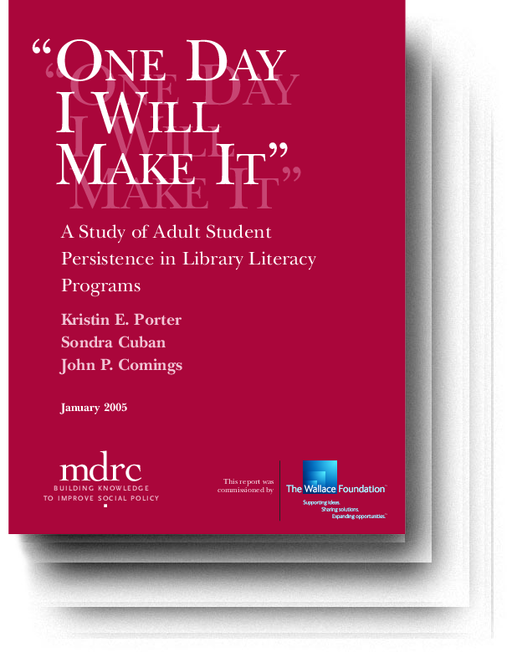Breadcrumb
- Wallace
- Reports
- One Day I Will Make It A Study O...
One Day I Will Make It
A Study of Adult Student Persistence in Library Literacy

Summary
How we did this
The participating libraries were granted resources to develop and implement persistence strategies that included improved instruction, more varied and more extensive social supports, and technology upgrades. This final report from the persistence study examined the implementation and effects of these strategies in nine library literacy programs over four years and whether student participation changed over time. The design involves measuring student achievement at two points in time—approximately 12 months apart—with a battery of literacy tests.
Illiteracy can keep adults from finding and keeping employment and from reaching their potential in all areas of life. Research suggests that adults need 100 to 150 hours of instruction to advance one grade level. But the average student participates for only 70 hours per year.
Wallace launched the Literacy in Libraries Across America (LILAA) initiative in 1996 to help library-based literacy programs nationwide increase the persistence of their adult learners. It contracted with MDRC and the National Center for the Study of Adult Learning and Literacy (NCSALL) at Harvard University in 1999 to study the initiative. The participating libraries were granted resources to develop and implement persistence strategies. These strategies included improved instruction, more varied and more extensive social supports, and technology upgrades.
This is the fourth and final report from the persistence study. It examines the implementation and effects of these strategies in nine library literacy programs over four years and whether student participation changed over time.
Key Findings
Adults who participated in the LILAA programs shared a desire to improve their low literacy skills, but otherwise they were a diverse group. The programs attracted more women than men, and students’ ages ranged broadly. Most participants were people of color, with each site drawing a third or more of its students from a single racial or ethnic group. Many students were recent immigrants who wanted to learn English, while others were native English speakers who wanted to improve their literacy and basic skills.
Overall, the literacy levels of students in the programs were low, and the length and intensity of students' participation fell short of the exposure needed to make large improvements in literacy levels. The severity of the problems varied across the different programs. For example, exit rates six months after program entry ranged from 44 percent to 84 percent. This wide range could reflect differences in types of students, recruitment procedures, or strategies for raising student engagement.
There were modest improvements in student achievement, measured by standardized tests. A sample of students took achievement tests at the beginning of the study, and about two-thirds took the same tests approximately one year later. For these students, there were small but meaningful average gains on the tests that measured overall reading comprehension. But there was little or no improvement on other tests measuring phonemic decoding and vocabulary.
Students in the LILAA programs faced many barriers to consistent participation. These included long and unpredictable work hours, health problems, lack of family support, undiagnosed learning disabilities, and unmet transportation and childcare needs. Most of the LILAA programs were reluctant to develop a social service capacity to help, and when they did offer social services, implementation proved difficult.
Programs were more successful in making programmatic improvements than in offering social services. Some strategies such as off-site instruction, drop-in classes, and expanded self-paced computer-assisted instruction, made literacy services more accessible. Others such as improved tutor training, were designed to make students feel more welcome and more comfortable.
What Library Literacy Programs Might Try Next
The report found five pathways taken by LILAA students: try-out, short-term, intermittent, mandatory (required, for example, by a law enforcement agency) and long-term.
The authors encourage library literacy programs to acknowledge the different pathways and work to improve persistence of students in all of them by:
- Offering realistic support services, such as on-site childcare
- Developing a referral system to other social service and education providers better suited than libraries to assist students in overcoming barriers to persistence
- Adapting and adding programmatic improvements, such as a sponsorship program and the creation of learning plans
- Improving communication, especially with students who find barriers to participation but are working to overcome those barriers
- Acknowledging the difficulty of persistence and removing any stigmas associated with irregular or sporadic participation
Key Takeaways
- Illiteracy can keep adults from finding and keeping employment and from reaching their potential in life.
- Public libraries have long been important providers of adult education. But students in adult literacy programs face many barriers to consistent participation. These barriers include long and unpredictable work hours, health problems, lack of family support, unmet transportation and childcare needs, and undiagnosed learning disabilities.
- There are a number of pathways to participation in adult literacy programs. Libraries should acknowledge these pathways in creating adult literacy programs and remove stigmas attached to any of them.
- Libraries can encourage more persistent attendance at adult literacy programs by offering realistic support services, such as on-site childcare and some forms of counseling.

